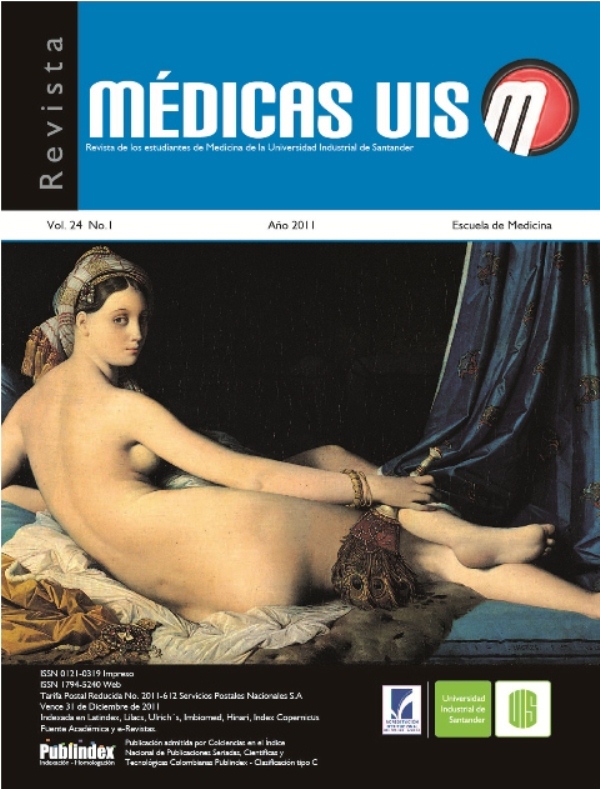Abstract
Pharmacovigilance in the last 10 years: update of concepts and classifications. Achievements and challenges for thefuture in ColombiaIntroduction: the science and activities relating to the detection, assessment, understanding and prevention of adverseeffects or any other drug related problem. Since the creation of the Colombian Pharmacovigilance Program led by INVIMA(National Institute of Drug and Food Surveillance) in 1998, there have been significant progress and there are numerousresearch Colombian experiences regarding this topic. They have also been updated some important concepts and classificationsfor the practice of the discipline. Objectives: to present published studies on adverse drug reactions/adverse drug events(ADR/ADE) in Colombian patients. Also, to describe the history of Pharmacovigilance in Colombia in briefly, and update themost important definitions and classifications. Methods: the databases reviewed were Medline, SciELO, LILACS and EMBASE.Results: there were 13 published studies aimed at detecting ADR/ADE in Colombian patients, conducted between 1998 and2007. The frequency of ADR/ADE in hospitalized patients was between 1.2 and 45% while the same frequency as the reasonfor consultation or hospitalization was between 0.03% and 6.8%. These figures overlap with the international literatureand differences between frequencies are mainly explained by the detection system that was used. The new classificationsclinical and mechanistic (DoTS and EIDOS) of ADR seem to be very useful in practice, one of which was used successfullyin a Colombian study. Conclusions: the Pharmacovigilance in Colombia has made significant progress in the last decade.However, it is necessary to improve the articulation of responsibilities between all actors involved and make the detectionand reporting of ADR/ADE a routine practice by all health professionals, especially for those drugs that have recently beenmarketed.
Keywords: Pharmacoepidemiology. Colombia. Drug utilization. Medicamentous disease. Secondary effect. Emergency medicalservices. Hospitalization. Ambulatory care.
References
2. Aronson JK, Ferner RE. Clarification of terminology in drug safety. Drug Saf.2005;28:851-70.
3. Delamothe T. Reporting adverse drug reactions. BMJ. 1992;304:465.
4. LaCroix AZ, Wienpahl J, White LR, Wallace RB, Scherr PA, George LK, et al. Thiazide diuretic agents and the incidence of hip fracture. N Engl J Med.1990;322:286-90.
5. Felson DT, Sloutskis D, Anderson JJ, Anthony JM, Kiel DP. Thiazide diuretics and the risk of hip fracture: results from the Framingham Study. JAMA.1991;265:370-3.
6. U.S. National Institutes of Health. National Library of Medicine. NLM Gateway. 2010. Último acceso: 4 de octubre de 2010. Disponible en: http://gateway.nlm.nih.gov/gw/Cmd?GMMTSearch%26loc=nccs.
7. Comité de consenso GIAF-UGR, GIFAF-USE, GIF-UGR. Tercer Consenso de Granada sobre Problemas Relacionados con Medicamentos (PRM) y Resultados Negativos asociados a la Medicación (RNM). Ars Pharm 2007;48:5-17.
8. Ishikura F, Beppu S, Hamada T, Khandheria BK, Seward JB, Nehra A. Effects of Sildenafil Citrate (Viagra) Combined With Nitrate on the Heart. Circulation 2000;102:2516-21.
9. Calderón C, Salcedo A. Ibuprofen increases soft tissue infections in children. BMJ 2008;337:707.
10. Laporte JR, Tognoni G. Estudios de utilización de medicamentos y farmacovigilancia. En: Laporte JR, Tognoni G (ed). Principios de Epidemiología del Medicamento. Barcelona: Masson-Salvat (colección Salud Pública); 1993. p. 2-24.
11. Berkowitz B. Desarrollo y regulación de Fármacos. En: Katzung B, Masters S, Trevor A (ed). Farmacología Básica y Clínica. México: McGraw-Hill; 2010. p. 67-75.
12. Silverman W. The Schizophrenic Career of a “Monster Drug”. Pediatrics 2002;110:404-6.
13. Kernan W, Viscoli C, Brass L, Broderick JP, Brott T, Feldmann E, et al. Phenylpropanolamine and the risk of hemorrhagic stroke. N Engl J Med 2000;343:1826-32.
14. U.S. Food and Drug Administration. Phenylpropanolamine (PPA) Information Page. Último acceso: 4 de octubre de 2010. Disponible en: http://www.fda.gov/drugs/drugsafety/informationbydrugclass/ucm150738.htm.
15. Medicines and Healthcare products Regulatory Agency (MHRA). Último acceso: agosto 30 de 2010. Disponible en: http://www.mhra.gov.uk/Safetyinformation/Howwemonitorthesafetyofproducts/Medicines/BlackTriangleproducts/index.htm.
16. Amariles P, Giraldo N, Toro VE, Restrepo MM, Galvis D, Pérez JA. Método DÁDER de seguimiento farmacoterapéutico y farmacovigilancia en instituciones de salud de Colombia. Vitae 2005;12:29-38.
17. Segura O, Pacific H. ¿Es posible un sistema nacional de farmacovigilancia en Colombia? Vía salud 2003; 22: 34–7.
18. Vacca C. Red Nacional de Farmacovigilancia: ¿Qué es y cómo funciona? Rev. Colomb. Cienc. Quím. Farm. 2006;35:285-288.
19. Instituto Nacional de Vigilancia de Alimentos y Medicamentos (INVIMA). Programa Nacional en Cifras. Boletín Informativo de Farmacovigilancia 2009;3:1-14.
20. Segura O, Pacific H. Frames of mind, practices and needs of the health professionals with regards to pharmacovigilance and pharmacoepidemiology: a descriptive study. Acta Med Colomb. 2003;28:181-84.
21. Miranda H, Buriticá O, Ayala O. Eventos Adversos a Medicamentos en los Servicios de Medicina Interna del Hospital de Caldas. Acta Med Colomb. 2003;9:1-7.
22. Dennis R, Gutiérrez JM, Rodriguez MN. Creación de un programa piloto de farmacovigilancia en el Hospital Universitario de San Ignacio. Acta Med Colomb. 1998;23:15-22.
23. Tribiño G, Maldonado C, Segura O, Díaz J . Direct costs and clinical aspects of adverse drug reactions in patients admitted to a level 3 hospital internal medicine ward. Biomedica. 2006;26:31-41.
24. Segura O, Maldonado C. Las reacciones adversas a medicamentos: una aproximación desde el punto de vista económico. Biomédica. 2003;23:401-7.
25. Vallejos A. Reacciones adversas por antibióticos en una unidad de cuidado intensivo pediátrico y neonatal de Bogotá. Biomédica. 2007;27:66-75
26. López LC, Botero M, Pino J, Ramírez JH, Palacios M. Adverse drug reactions in internal medicine units at a university hospital: A descriptive pilot study. Colomb Med. 2010;41:46-51.
27. Bustamante C, Calderón C, Castillo I, Cifuentes P, Ramírez J. Reacciones adversas a medicamentos en pacientes adultos hospitalizados de la Clínica Universitaria Teletón. Boletín de Farmacovigilancia del INVIMA. 2007; 18: 8–13.
